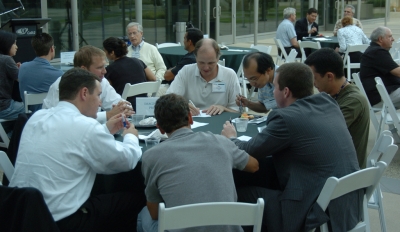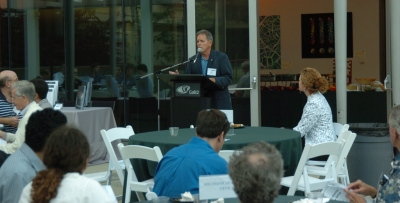Medical Devices Affinity Group Meets to Brainstorm New Technologies
|
San Diego, CA, August 7, 2007 -- Nearly 40 researchers, clinicians, basic scientists and engineers from the UCSD division of the California Institute for Telecommunications and Information Technology (Calit2), the Jacobs School of Engineering and the UCSD School of Medicine's Department of Surgery met to brainstorm about potential collaborations to develop new medical and research devices.
Calit2 UCSD spearheaded the brainstorming work group, held on July 26 at Atkinson Hall, as part of the Engineering in Medicine Initiative (EMI), a joint initiative with the Jacobs School and the School of Medicine. The goal of the Affinity Group is to foster interdisciplinary collaborations to speed the development of new technologies for use in medicine and the life sciences, which will ultimately benefit the public. The event was sponsored in part by the San Diego office of Morrison and Foerster, a law firm specializing in intellectual property.
"I really liked the meeting. I have always wanted to explore the possibility of applying bioengineering in the enhancement of developing new treatments, methods of disease detection and tools for basic science research," said Shauna Yuan, a neurologist. "There were some good ideas being discussed that were useful and I met some people whom I could potentially work with." Her area of research is Alzheimer's Disease.
This was the second in a series of events designed to bring together researchers, clinicians and engineers to discuss their specific needs and expertise, find areas of mutual interest and brainstorm about what could be possible, with an eye on continuing after the evening's end to develop an idea into a full-fledged multidisciplinary collaboration. Calit2's role is to make available the necessary ongoing support for these projects, including such things as facilities, equipment and technical expertise.
|
Conversations between surgeons Garth Jacobsen and John Cullen and Computer Science & Engineering's (CSE) Serge Belongie may have begun just such a project, regarding 'horizon finding' for endoscopy and advanced natural orifice surgery procedures. Under current conditions, it is often difficult for surgeons to tell which end is up on an endoscopic image. In addition, because the vision and working instruments are linked together on a single platform, most actions taken by the surgeon with the endoscope alter the visual horizon.
"This can be challenging to the endoscopist or surgeon and often the horizon (and the optimal view) is sacrificed in order to perform an operative task," said Cullen, "This is like trying to fly an airplane upside down and is something we have learned to accept and struggle with. But as we push the limits of what the endoscope can achieve operatively, we must also refine its visual capabilities.
"Several ideas were presented to us as possible means to generate real-time horizon stability. We are very excited for the potential of this technology in several surgical disciplines," added Cullen. CSE's Belongie explained, "The idea would be to use image processing techniques to do 'horizon finding' on laprascopic images and use that to rectify the image displayed to the doctor. We discussed the possibility of making it a topic for my winter engineering projects course, which follows my yearly fall offering on image processing."
Although such joint endeavors might be expected to arise naturally, clinicians seldom have an opportunity to explore their ideas for new devices with the researchers and engineers who can actually design, develop and build them. The Affinity Group is meant to provide precisely such opportunities to meet, after which, Calit2 is available to support the move from brainstorm to bench.
"This meeting plants the seeds for future meetings," said Yu-Hwa Lo, from the Electrical and Computer Engineering (ECE) department, "where discussions are expected to be more focused on a specific set of problems."
|
Alan Hargens of Orthopaedic Surgery said, "Thanks for the event! We hope to collaborate with people at UCSD who have more experience than we do bringing a device from the lab to a commercial product. And we made contact with two attendees with whom we will be following up."
In addition, scientists in various fields across campus often do not have the opportunity to find needed expertise outside their field to develop an interdisciplinary project, nor the kind of focused time provided by the event to brainstorm with colleagues.
"I benefited from the informal interactions with many people I wouldn't have had the chance to meet or talk to otherwise," said ECE's Lo, "The conversations become stimulating when people don't have to rush to the next meeting. Interestingly, I even got some good ideas and advice from my engineering colleagues, mainly because during the meeting, we are all focused on creating engineering solutions for medicine."
"It was great. I met people that I did not know were on this campus," noted Paul Blair, Calit2 project scientist, "I'm interested in commodity devices and taking them out of the hospital and emergency situation and putting them into people's homes, their daily lives."
"The Affinity Group meeting served an excellent purpose of getting people to meet and exchange information," said Shu Chien, the director of the Whitaker Institute of Biomedical Engineering at UCSD, "Since this is an area of focus in the new Engineering in Medicine Initiative (EMI), I am pleased to see so many participants. Laura Wolszon and her colleagues in Calit2 did a wonderful job preparing for the event, which was very enjoyable." Chien is the director of the EMI and a professor in both bioengineering and medicine.
The next Medical Devices Affinity Group meeting is slated for September and, as is always the case, open to all UCSD academics, researchers and students. Please contact Laura Wolszon, Calit2 UCSD manager of Strategic Alliances, if you have any questions, or would like to attend; her email is Lwolszon@ucsd.edu.



